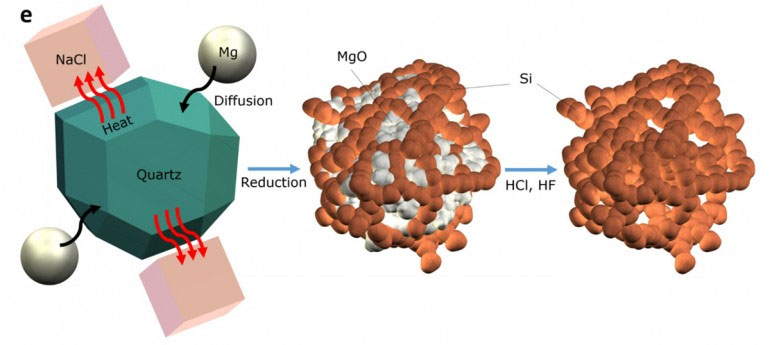
باتریهای لیتیوم-یون معمولی از آند ساخته شده با گرافیت استفاده میکنند، اما اغلب افراد معتقدند که دیگر عملکرد این ماده به اوج خود رسیده و از این رو پژوهشگران به فکر یافتن جایگزینهای ممکن برای ساخت آند افتادهاند. در این بخش بسیاری بر سیلیکون نانومقیاس تکیه کردهاند، اما تولید این ماده در مقادیر زیاد سخت بوده و اغلب نیز زود تخلیهی انرژی میشوند. پژوهشگران دانشگاه ریورساید کالیفرنیا به این مشکلات با توسعهی آند باتری لیتیوم-یون با استفاده از ماسه و شن پایان دادند.
هنگامی که زاخاری فیورز، فارغالتحصیل دانشگاه ریورساید مشغول کار بر روی توسعهی بیشتر باتریهای لیتیوم-یون بود، برای استراحت به ساحل سان کلمنتو میرفت و متوجه شد که شنهای این ساحل از کوارتز یا دیاکسید سیلیکون تشکیل شدهاند، این مساله وی را ترغیب به انجام تحقیقات بیشتر کرد. وی به تحقیق بر روی ساحلهای متفاوت ایالات متحده جهت یافتن ساحلی با مقدار درصد کوارتز بیشتر پرداخت و به تحقیقات خود در ساحل Cedar Creek Reservoir تگزاس خاتمه داد.

او مقداری از شن ساحل تگزاس را به آزمایشگاه خود در کالج مهندسی Bourns دانشگاه ریورساید کالیفرنیا آورد و با کمک استادان رشتهی مهندسی، سنگیز و میهیری ازکان به کار بر روی آن پرداخت. فیورز ابتدا به خرد کردن شنها در مقیاس نانومتر پرداخت، قبل از اینکه گامهای پالایش آن را آغاز نماید.
وی سپس نمک و منیزیم را درون کوارتز تصفیه شده قرار داد و پودر منتج شده را حرارت داد. در این فرایند بسیار ساده، نمک مانند یک جذبکنندهی حرارتی عمل کرده است، در حالی که منیزیم به جداسازی اکسیژن از کوارتز پرداخت که منجر به سیلیکون خالص شد. علاوه بر این، نانوسلیکون خالص در یک ساختار اسفنجی مانند سهبعدی و بسیار پرمنفذ شکل میگیرد. داشتن منافذ زیاد یکی از نکات مهم پیشرفت عملکرد آندهای باتری میباشد و سطح وسیعی را ایجاد مینماید و به لیتیوم-یونها امکان حرکت سریعتر از بین هم را میبخشد.

گروه تحقیقاتی فیورز موفق به ساخت یک باتری لیتیوم-یون به اندازهی یک سکه با استفاده از آند جدید شده که طبق ادعای آنها به طور قابل توجهی عملکرد باتریهای لیتیوم-یون را ارتقا بخشیده است. آنها میگویند عملکرد بهبود یافتهی الکترودهای نانوسیلیکون میتواند منجر به افزایش سه برابری عمر باتری دستگاههایی مانند تلفنهای همراه و خودروهای الکتریکی شود.
این پژوهشگران اکنون به دنبال راهی برای تولید نانوسیلیکونها در مقادیر زیاد و ساخت باتریهای اندازهی بزرگتر نسبت به باتری که اکنون موفق به ساخت آن شدند، میباشند.
جزئیات این پروژه در مجلهی Scientific Reports منتشر شده است.
منبع : gizmag
Conventional lithium-ion batteries rely on anodes made of graphite, but it is widely believed that the performance of this material has reached its zenith, prompting researchers to look at possible replacements. Much of the focus has been on nanoscale silicon, but it remains difficult to produce in large quantities and usually degrades quickly. Researchers at the University of California, Riverside have overcome these problems by developing a lithium-ion battery anode using sand.
When Zachary Favors, a graduate student at UC Riverside working on developing better lithium-ion batteries, noticed that the beach sand he was relaxing on after surfing in San Clemente, California was primarily made up of quartz, or silicon dioxide, it prompted him to delve a little deeper. Researching where in the US sand could be found with a high percentage of quartz, he ended up at the Cedar Creek Reservoir in Texas.
He collected some of the sand and took it back to a lab at the Bourns College of Engineering at UC Riverside where he worked with engineering professors Cengiz and Mihri Ozkan. Favors started milling the sand down to the nanometer scale before putting it through a series of purification steps that gave it a similar color and texture to powdered sugar.
He then ground salt and magnesium into the purified quartz and heated the resulting powder. In this very simple process, the salt acted as a heat absorber while the magnesium removed oxygen from the quartz, resulting in pure silicon. More than that, the pure nano-silicon formed in a very porous, 3D silicon sponge-like consistency. Porosity is one of the keys to improving the performance of battery anodes as it provides a large surface area and allows lithium ions to travel through them more quickly.
The team has developed a coin-sized lithium-ion battery using the new anode that they claim significantly outperforms conventional lithium-ion batteries. They say the improved performance of the nano-silicon electrode could be expected to equate to a threefold increase in battery life for devices such as mobile phones, which would only need to be recharged every three days rather than every day, and electric vehicle batteries that last three times longer, cutting down on expensive replacement costs.
The researchers are now looking to produce the nano-silicon in larger quantities and move from coin-size batteries to pouch-size batteries like those used in mobile phones.
Patents have been filed for the technology, which is detailed in the journal Scientific Reports.
 گجت نیوز آخرین اخبار تکنولوژی، علم و خودرو
گجت نیوز آخرین اخبار تکنولوژی، علم و خودرو 





